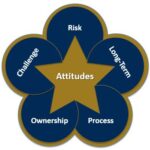Frustration may be your most significant obstacle to achieving your goals. Every ski racer, from juniors to Olympians, has experienced the feeling of frustration when you’re not able to do something as you pursue your goals; you feel stuck, get uptight, lose focus, and get discouraged. The best way I can describe the feeling is: AAARRGGHH!! It is a truly infuriating feeling.
But what is frustration precisely and what causes it? Simply put, frustration arises when the path toward your goal is blocked, whether the goal is skiing a straighter line or getting a good result. Most people think of frustration as a bad emotion, but it is actually more complex than that. The fact is that frustration is hard wired into us and has tremendous adaptive value. Frustration starts as a good emotion because when you get frustrated, you’re motivated to remove the obstacle that is blocking the path toward your goals. You try harder and that extra effort may result in clearing that path enabling you to continue to pursue of your goals.
Negative Emotional Chain
Unfortunately, if, despite your best efforts, you can’t overcome those roadblocks, frustration can become a destructive emotion. In fact, if frustration isn’t dealt with quickly and positively, it can trigger what I can the “negative emotional chain” in which the frustration leads to a descent into a series of truly unhealthy emotions and a serious decline in performance.
 If the frustration isn’t relieved, it can morph into anger. Most people also believe that anger is a bad emotion, but, like frustration, it too has both positive and negative sides. Anger starts out as being helpful because it too is motivating. When you’re angry, you want to go after the thing that is causing your anger. I remember one race I was in while skiing for Middlebury in which I was absolutely livid because the officials changed my time in the race the day before and I lost out on a trophy. I was so angry I attacked that day’s courses like a madman and I won!
If the frustration isn’t relieved, it can morph into anger. Most people also believe that anger is a bad emotion, but, like frustration, it too has both positive and negative sides. Anger starts out as being helpful because it too is motivating. When you’re angry, you want to go after the thing that is causing your anger. I remember one race I was in while skiing for Middlebury in which I was absolutely livid because the officials changed my time in the race the day before and I lost out on a trophy. I was so angry I attacked that day’s courses like a madman and I won!
Unfortunately, more often than not, angry can turn into an emotion that hurts your skiing. The feelings of anger are like those of frustration, but with the volume turned way up. Your body becomes tense you lose your coordination and the quality of your efforts decline. Your focus narrows so much that you miss important cues on the course, such as terrain changes. And your ability to think becomes clouded by the anger, so you aren’t able to make good pre-race or tactical decisions.
If you aren’t able to clear the obstacles from your path at this point, your emotions shift to the final stage of the negative emotional chain; you experience despair. You have tried and tried and tried and still can’t remove the barriers, so the natural thing to do is quit. What’s the point of continuing to try if nothing you do works? The unfortunate outcome of the conclusion of the negative emotional chain is immediate failure to achieve your goals.
 It has been my experience that if you move from frustration to anger to despair, continued efforts that day usually fail. And if you experience the negative emotional chain on a regular basis—sinking repeatedly into despair—you will likely lose your motivation and be unwilling to make a sustained effort in the future. With each descent down the negative emotional chain, you come to believe that your actions have little effect and you will progressively lose confidence in your ability to achieve your goals.
It has been my experience that if you move from frustration to anger to despair, continued efforts that day usually fail. And if you experience the negative emotional chain on a regular basis—sinking repeatedly into despair—you will likely lose your motivation and be unwilling to make a sustained effort in the future. With each descent down the negative emotional chain, you come to believe that your actions have little effect and you will progressively lose confidence in your ability to achieve your goals.
Learn Frustration Mastery
Despite the fundamental role that frustration plays in your efforts to be your best, you probably never were taught how to deal with your frustration in a constructive way. Your goal is to learn to stop the negative emotional chain at frustration by responding positively to the frustration when it first arises.
Take a break. The first mistake that many people make—and that parents often encourage—when faced with frustration is to just increase your effort, in other words, do whatever you are doing more and harder. But then you are violating the Law of Insanity: doing the same thing and expecting different results.
When frustration first arises, rather than plowing ahead, you should do just the opposite, in other words, step back from the situation that is causing the frustration. For example, if you repeatedly miss a tough gate over a knoll in training, you should first take a break. The break creates emotional distance from the frustration, thus easing its grip on you.
Relax. When you get frustrated, your body tenses up. If you tried to clear the path to your goals now, you would fail miserably because your body just isn’t in a place where it can do what you want it to do.
So, as a part of your break, you should do things to help you relax. You could take some deep breaths, actively relax your muscles, or have a snack or drink. This step lessens the uncomfortable physical symptoms that accompany frustration and prepares your body to do what you need to do to overcome the source of the frustration.
Generate positive emotions. Next, you should do something that creates emotions that are the opposite of frustration, for example, chat it up with your friends, listen to music, or take a free run. Doing this generates emotions, such as happiness or fun, that can counteract the feelings of frustration. A powerful way to counter the feelings of frustration when you take a break from training is to do something at which you can succeed, for instance, section the course below the knoll, thus feeding your feelings of confidence and generating positive emotions such as pride and hope.
Get perspective. A powerful contributor to frustration is that you’ve lost perspective. What I mean by this is that you’re likely impatient and expect to progress as a ski racer much faster than is reasonable. For example, you may believe that you should “get” some new technique or tactic immediately when, in fact, it takes a long time to make a major improvement in your skiing.
Having perspective means understanding that progress takes time and that you’re willing to put in the time and energy to see your efforts reach fruition.
Identify the problem. You may think that, having taken a break, relaxes your body, generated positive emotions, and gained perspective, you are ready to return to the course that caused your frustration. But you’re not because whatever caused your frustration is still there.
Your next step is to figure what the problem is. If you know what the specific problem is, then you have a better chance at finding a solution and removing any more chances of experiencing frustration. Returning to the example of the tough gate below the knoll, you can ask your coach what is causing your problems (e.g., going to straight at the gate on the knoll).
Find a solution. With the problem identified, your final step is to find a solution to it. Again, returning to the “tough gate” example, you can solve the problem by setting up high and finishing your turn above the gate.
Change your goals for the day. The reality is, though, that you can’t always immediately clear the obstacles to your goals, so continued efforts in pursuit of those goals might be futile. The barriers may be just too great to surmount on that day. In this case, you can change your goals to ones that can be achieved in the short term. For example, let’s say you are getting frustrated because you had a poor first race run and you’re too far out to have a good result. If your goal remains to have a good result, you are sure to continue being frustrated. In that situation, it would be easy for you to despair and just blow off the second run. But if you can come up with a new goal for the second run, say, to “attack from the back” and see how fast you can go because you have nothing to lose, you may have a good second run and end the day feeling more upbeat (as well as learning a lesson about how to deal with frustration).
Do something different. Finally, there are going to be days when you just aren’t going to make any progress toward your goals and continuing to try without success will just discourage you more and actually hurt your efforts in the long run. In this case, it may be wise to stop training and do one of two things. First, you could do something unrelated to your skiing but that will help your skiing indirectly such as doing your homework, taking a nap, or even having some fun. Second, you could do something that helps your skiing directly, for example, tuning your skis or doing a conditioning workout.
The key is to recognize when frustration begins to build in you, so you can immediately take the above steps to combat it. In doing so, you recover from your frustration more quickly and can get back on that road to your ski racing goals.
It’s never too late to begin mental training during a race season. Take a look at my online mental training courses designed specifically for ski racers.






